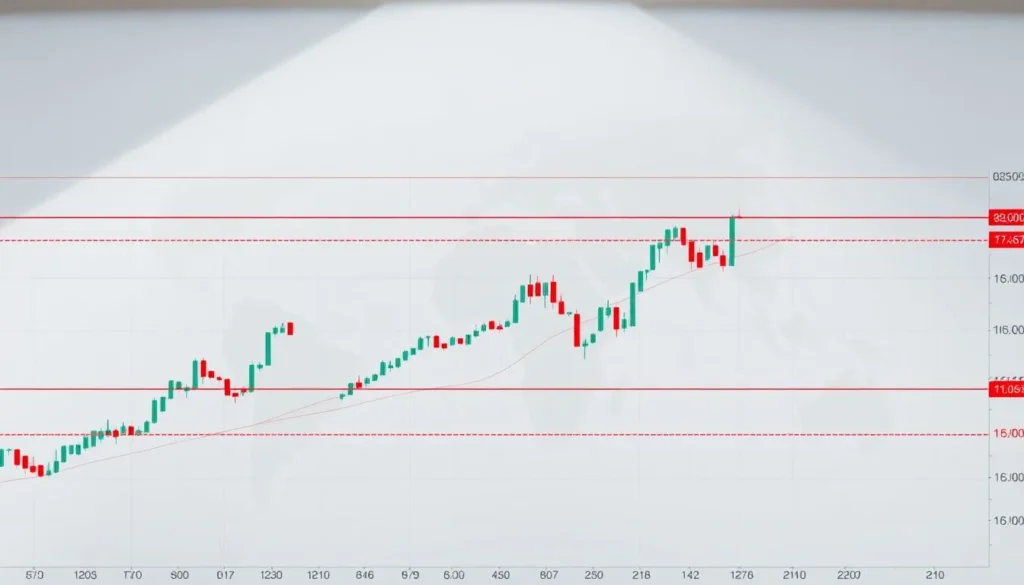The USD/CAD currency pair is a key focus in the forex market. Its changes affect traders and investors a lot. A big change in this pair can show broader market trends. Everyone needs to keep up with these changes.
Looking into the usd/cad Currency Pair reversal, we need to look at expert analysis. This can give us insights into the market. This article will give a detailed look, using expert views to understand what’s happening and what might happen next.
Current Market Overview of USD/CAD
The USD/CAD pair is at a critical point, with technical signs pointing to a possible change. The forex market is known for its ups and downs. The USD/CAD is no different, influenced by many factors like economic data, central bank actions, and global events.

Recent Price Action and Volatility
The USD/CAD pair has seen big changes in price recently. It’s important for traders to understand these shifts to spot possible turning points.
Key Price Movements in the Past Week
In the last week, the USD/CAD pair has moved a lot. It hit important support and resistance levels. This movement is both a risk and an opportunity for traders.
Volatility Metrics and Comparisons
Volatility shows the USD/CAD pair is at the high end of its usual range. Comparing it to other major pairs helps traders see the risks and rewards.
| Currency Pair | Current Volatility | Historical Average |
| USD/CAD | High | Medium |
| EUR/USD | Medium | Low |
| GBP/USD | High | High |
Key Support and Resistance Levels
Knowing the key support and resistance levels is vital for traders. It helps them predict price movements.
Short-term Technical Boundaries
In the short term, the USD/CAD pair is limited by key technical levels. These levels have been tested many times. Crossing them could signal a big move.
Long-term Structural Levels
Looking at the long term, the USD/CAD pair is shaped by structural levels. These levels reflect broader market trends and economic basics.
“The USD/CAD exchange rate is sensitive to changes in oil prices and economic data releases from both the U.S. and Canada,” said a forex analyst. “Understanding these dynamics is key to predicting future movements.”
USD/CAD: Expert Analysis & Insights
Technical indicators and chart patterns are key to understanding the USD/CAD’s reversal. Experts use these tools to predict market movements. They combine technical indicators and chart patterns for their analysis.
Technical Indicators Signaling Reversal
Technical indicators are vital for spotting reversals in USD/CAD. They include leading and lagging indicators, each giving different insights into the market.
Leading Indicator Signals
Leading indicators like the Relative Strength Index (RSI) and Stochastic Oscillator forecast future price movements. They signal oversold or overbought conditions, hinting at a reversal.
For example, an RSI below 30 means the market is oversold, hinting at a rise. An RSI above 70 means it’s overbought, suggesting a fall.
Lagging Indicator Confirmations
Lagging indicators, such as Moving Averages and MACD (Moving Average Convergence Divergence), confirm trends and reversals. A crossover in moving averages or a MACD divergence can signal a change.
| Indicator | Description | Reversal Signal |
| RSI | Measures the magnitude of recent price changes | Oversold (70) |
| MACD | Shows the relationship between two moving averages | Crossover or Divergence |
| Stochastic Oscillator | Compares the closing price to its price range over a period | Oversold or Overbought conditions |
Chart Patterns and Formation Analysis
Chart patterns offer visual clues about market movements. Recognizing these patterns helps traders predict reversals.
Head and Shoulders Pattern Identification
The Head and Shoulders pattern signals a trend change. It has a peak (head) and two smaller peaks (shoulders).

Trend lines and channel formations are key for spotting reversals. A break above or below these lines signals a change.
Traders watch for these breaks to confirm market direction.
Breaking News Impacting USD/CAD Direction
Breaking news, like economic data releases, is key in shaping the USD/CAD direction. The USD/CAD pair is very sensitive to economic data from the U.S. and Canada. It also reacts to statements from their central banks.
Recent Economic Data Releases
Economic data releases have a big impact on the USD/CAD exchange rate. Recent reports have shown mixed results, affecting market trends.
U.S. Employment and Inflation Reports
The latest U.S. employment figures showed a mixed labor market. Non-farm payrolls rose by 175,000 last month. Inflation reports showed a moderate rise in consumer prices, influencing the Federal Reserve’s policy outlook.
Canadian GDP and Trade Balance Figures
Canada’s GDP growth was slightly above expectations, thanks to a surge in exports. But the trade balance was disappointing due to increased imports. This could affect the Bank of Canada’s monetary policy decisions.
| Economic Indicator | U.S. Data | Canadian Data |
| GDP Growth Rate | 2.1% | 1.8% |
| Inflation Rate | 2.5% | 2.2% |
| Unemployment Rate | 3.8% | 5.2% |
Central Bank Communications and Policy Shifts
Traders closely watch Central bank communications. They look for hints on future monetary policy directions.
Federal Reserve Statements and Minutes
The Federal Reserve’s latest statement showed a cautious approach to monetary policy. It hinted at a possible rate cut shortly.
Bank of Canada Policy Announcements
The Bank of Canada maintained its hawkish stance. It signaled a possible rate hike to combat inflationary pressures.

Fundamental Factors Driving the Potential Reversal
To understand the USD/CAD reversal, we must look at economic data and central bank actions. The U.S. and Canadian economies and their central banks shape the currency pair’s path.
U.S. Economic Indicators and Federal Reserve Policy
The U.S. economy’s health affects the USD/CAD rate. Important indicators like GDP growth, inflation, and employment data show the U.S. economy’s state. The Federal Reserve’s policies, including interest rates, also impact the USD’s value against the CAD.
- GDP Growth Rate: A higher GDP growth rate can strengthen the USD.
- Inflation Rate: Rising inflation may lead to higher interest rates, attracting investors to the USD.
- Employment Data: Strong employment figures can boost the USD.
Canadian Economic Performance and Bank of Canada Stance
Canada’s economy and the Bank of Canada’s policies are key to the CAD’s value. Watched indicators include the inflation rate, the employment rate, and the GDP growth. The Bank of Canada’s interest rate decisions and forward guidance influence the CAD.
Canada’s economic data shows mixed signs. Some indicators suggest a slowdown, while others show resilience. This mix can cause CAD volatility, affecting the USD/CAD pair.
Oil Price Dynamics and Impact on CAD
Oil prices are vital for the CAD, as Canada is a major oil exporter. Higher oil prices strengthen the CAD, boosting the trade balance. Lower oil prices, on the other hand, can weaken the CAD, potentially reversing the USD/CAD pair.
- Rising oil prices: Strengthens CAD, potentially reversing USD/CAD.
- Falling oil prices: Weakens CAD, potentially supporting USD/CAD.
The USD/CAD pair’s direction depends on U.S. and Canadian economic indicators, central bank policies, and oil prices. Traders and investors must watch these factors closely to navigate the reversal scenario.
Expert Opinions on USD/CAD Trajectory
As market dynamics change, expert insights on the USD/CAD trajectory are more valuable than ever. The future of this currency pair is a hot topic among financial experts. Different factors shape their predictions.
Wall Street Analysts’ Perspectives
Wall Street analysts keep a close eye on the USD/CAD pair. They offer a detailed technical analysis to guess its next steps. Many think the pair is about to see a big change, thanks to recent economic news and central bank talks.
Some say the rising Canadian dollar could push the USD/CAD pair down. But others believe a US dollar rebound could balance this out. This makes the market situation more complex.
Central Bank Economists’ Forecasts
Central bank economists also share their views on the USD/CAD pair. They look at big economic trends and money policy choices. Their forecasts often talk about how interest rate differences between the US and Canada affect the pair.
Some economists think the diverging monetary policies between the Federal Reserve and the Bank of Canada will impact the exchange rate. They believe this could lead to a big change.
Independent Forex Strategists’ Views
Independent forex strategists offer various opinions on the USD/CAD pair. They often use technical analysis and look at chart patterns. These experts highlight important support and resistance levels that could decide the pair’s next move.
Some strategists think dropping below certain support levels could mean the USD/CAD pair will fall further. Others see a chance for a rebound if the pair can get past key resistance levels.
Technical Analysis Deep Dive
We need to dive into technical analysis to understand the USD/CAD pair. We look at technical indicators and chart patterns. These can show when a big change might happen.
Moving Averages and Momentum Indicators
Moving averages are key for spotting trends. Simple and Exponential Moving Average Crossovers are big events. They show when market feelings might change.
Simple and Exponential Moving Average Crossovers
When the short-term average goes above the long-term, it’s good news. This is a sign of a possible upturn. But, if it goes below, it warns of a downturn.
RSI and MACD Signals
The Relative Strength Index (RSI) and Moving Average Convergence Divergence (MACD) are important. They help find out when prices are too high or too low. They also show when a trend might change.
Fibonacci Retracement Levels
Fibonacci retracement levels help find support and resistance. They use the highs and lows of a trend. Then, they divide the distance by key Fibonacci numbers.
| Fibonacci Level | Retracement Ratio | USD/CAD Price Level |
| 23.6% | 0.236 | 1.3200 |
| 38.2% | 0.382 | 1.3100 |
| 61.8% | 0.618 | 1.3000 |
Oscillators and Divergence Patterns
Like the Stochastic Oscillator, Oscillators show when prices are too high or too low. Price-Momentum Divergences happen when price and momentum go in opposite directions. This can signal a big change.
Stochastic Oscillator Readings
The Stochastic Oscillator compares closing prices to their range. High readings mean prices are too high. Low readings mean they’re too low.
Price-Momentum Divergences
Divergences between price and momentum are strong signals. For example, if prices keep increasing but the RSI doesn’t, it’s a bearish sign.
Historical Precedents for USD/CAD Reversals
Looking at the past helps us understand USD/CAD reversals. This currency pair has seen many big changes. These events teach us valuable lessons for trading today.
Previous Major Reversal Patterns
The USD/CAD pair has seen big changes before. These were often because of big economic events or changes in oil prices. For example, in 2008, the CAD fell against the USD. This was because Canada’s economy, which relies a lot on oil, was hit hard by the global crisis.
Some key historical reversal patterns include:
- The impact of oil price changes on CAD is that Canada is a big oil exporter.
- Changes in monetary policy by the Bank of Canada or the Federal Reserve affect interest rates.
- Big changes in economic data, like GDP or job numbers, were not expected.
Comparative Analysis with Current Situation
Looking at the past helps us understand today’s USD/CAD market. Today, the USD/CAD is affected by things like the economy getting better, oil prices, and central bank policies.
Key similarities between historical and current scenarios include:
- The ongoing effect of oil prices on CAD strength.
- The role of central bank policies in shaping currency values.
- The influence of global economic trends on USD/CAD movements.
Traders can improve their strategies by knowing these historical lessons and how they apply today. This helps them deal with the USD/CAD market’s complexities better.
Market Sentiment and Positioning Data
Market sentiment and positioning data fully represent the USD/CAD market. It’s key for traders to grasp these to tackle the forex market’s complexities.
Retail Trader Sentiment Analysis
Retail trader sentiment analysis shows how individual traders view USD/CAD. Many have been thinking that USD/CAD will go down, with lots of short positions.
This might signal a change, as retail traders are often the “crowd” others bet against. But, it’s vital to look at this with other market signs for a full picture.
Institutional Positioning and COT Reports
As seen in COT reports, institutional traders’ moves are very telling. These reports show big players like hedge funds and banks adjusting their bets based on economic news and central bank actions.
| Date | Non-Commercial Long Positions | Non-Commercial Short Positions |
| 2023-03-01 | 45,000 | 30,000 |
| 2023-03-08 | 42,000 | 32,000 |
| 2023-03-15 | 40,000 | 35,000 |
“The COT report is a powerful tool for understanding the sentiment of large traders. By analyzing these reports, traders can gain insights into possible market shifts.” –
Expert Opinion, Forex Analyst
Looking at retail trader sentiment and big traders’ moves helps traders better understand the USD/CAD market.
Potential Trading Strategies for the Reversal Scenario
A USD/CAD reversal could be a big chance for traders, but it also comes with risks. A good trading plan is key. Traders need to think about several important things.
Entry and Exit Points Consideration
Finding the best times to enter and exit the market is vital. This helps traders make more money and lose less. They should use technical analysis to spot key levels and forex trading signals for a reversal.
- Watch for support and resistance levels to find entry and exit points.
- Look at technical indicators like moving averages and RSI to see market trends.
- Also, expert analysis and market predictions should be considered for better decisions.
Risk Management Approaches
Managing risk is essential when trading on a USD/CAD reversal. Traders should use strategies like stop-loss orders and position sizing to reduce losses.
- Set stop-loss orders to control losses if the market goes against you.
- Use position sizing to manage how much capital you risk.
- Spread your trades to avoid too much risk on one currency pair.
Time Frame Considerations for Different Traders
The right trading time frame depends on the trader’s strategy and goals. Short-term traders might watch minute-by-minute changes. Long-term investors look at bigger trends.
Traders should pick a time frame based on their goals and how much risk they can take.
Immediate Market Implications
The USD/CAD currency pair is on the verge of a possible change. This is making the market very interesting for traders and investors. A change could mean big shifts in how the market moves.
Short-term Trading Opportunities
Traders might make money from this possible change by choosing the right positions. Buy or sell signals from technical tools could help find the best times to buy or sell.
Recent market data shows chances for trading. Here’s a summary of important points:
| Indicator | Current Value | Signal |
| RSI | 30 | Oversold |
| Momentum Indicator | -0.5 | Bearish |
| Moving Average | 1.3000 | Support |
Potential Impact on Correlated Currency Pairs
A change in the USD/CAD pair could affect other currency pairs too. Commodity currencies might be hit hard because they’re tied to oil prices.
Traders should consider how pairs like EUR/USD and GBP/USD might change. The USD’s strength or weakness could influence these pairs.
Conclusion: The Road Ahead for USD/CAD
The USD/CAD currency pair is at a critical juncture. Various factors suggest a possible reversal. Experts and market analysis warn traders to be cautious and ready for changes.
Recent price movements, technical indicators, and fundamental factors show a shift. The U.S. and Canadian economies and oil prices will influence the pair’s path.
Traders must closely watch expert opinions, market mood, and position data. Understanding the USD/CAD reversal complexities helps in making smart trading moves.
As the market changes, staying updated with forex analysis and expert views is key. This will help traders take advantage of the USD/CAD reversal.
FAQ
The USD/CAD trend changes due to many factors. For the latest insights, check our expert analysis on USD/CAD reversal.
Technical indicators are key for USD/CAD signals. Tools like moving averages and RSI help spot reversal patterns. This aids in making smart trading choices.
Support and resistance levels for USD/CAD come from technical analysis. Chart patterns and trend line breaks are used. These levels help predict price movements.
The Bank of Canada’s policies, like interest rate changes, affect CAD’s value. This, in turn, impacts the USD/CAD exchange rate.
Economic indicators like GDP and inflation rates are vital for USD/CAD analysis. They show the economic health of both countries, influencing the exchange rate.
Traders combine technical and fundamental analysis for USD/CAD predictions. They look at chart patterns, technical indicators, and economic data. Central bank policies also play a role.
Oil price changes affect CAD, as Canada exports a lot of oil. This can alter the CAD’s value against USD, impacting the USD/CAD rate.
Expert opinions from Wall Street and central banks offer valuable insights. They help traders understand different views on USD/CAD. This aids in making informed trading decisions.
For a USD/CAD reversal, consider entry and exit points, risk management, and time frames. Tailor these strategies to fit your trading goals and risk level.






